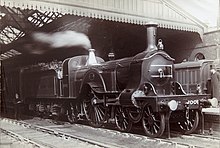Great Northern Railway (Great Britain)

The Great Northern Railway (GNR) was a British railroad company that existed from 1846 to 1922 . The length of the route network was 1692 km. Their main route ran from London via Hitchin , Peterborough and Grantham to York , with an alternative route from Peterborough via Boston and Lincoln to Bawtry south of Doncaster and branches to Sheffield and Wakefield . A large part of the GNR main line now forms the East Coast Main Line . The main workshops were in Doncaster.
history
The first section of the GNR was opened in 1848 between Louth and Grimsby , followed in 1849 by the route from Peterborough via Lincoln to Doncaster . In 1850 the GNR opened the routes London - Peterborough and Doncaster - York . In 1852 the main line between London and Doncaster was completed, and King's Cross Central Station in London was opened in the same year .
The direct route Peterborough - Grantham - Retford was opened in 1853 and by buying other companies or acquiring the rights of use, the GNR advanced to Bradford , Cambridge , Halifax , Leicester and Nottingham . In 1857 the GNR reached an agreement with the Manchester, Sheffield and Lincolnshire Railway (MS&LR) and was then able to offer express trains from London via Sheffield to Manchester. From 1858 the Midland Railway also used the GNR main line on the section south of Hitchin.
By the late 1850s, the GNR had access to all major cities in West Yorkshire . The profits from the coal transport between this area and London moved the Great Eastern Railway and the Lancashire and Yorkshire Railway to plan their own trunk line from Doncaster through Lincolnshire. However, the British Parliament rejected this plan in 1865 and 1871. The GNR, for its part, founded a joint subsidiary, the Cheshire Lines Committee (CLC), together with the MS&LR and the Midland Railway (MR) in 1865 to control rail traffic in the corridor between Manchester and Liverpool .
The GNR continued to grow in the 1870s, with the construction of new CLC lines and the expansion of the route network in Nottinghamshire and Leicestershire , which operated in this region together with the London and North Western Railway . With the purchase of the Eastern and Midlands Railway in 1889 (together with the MR), the GNR gained access to Norfolk .
In order to be able to offer direct trains to Scotland , the GNR cooperated from 1860 with the North Eastern Railway and the North British Railway ; the three companies procured rolling stock with uniform technical specifications in order to enable continuous operation on the East Coast Main Line. The most important express trains departed from London King's Cross and Edinburgh Waverley at 10 a.m. from 1862 onwards. In the 1870s these trains became known as the Flying Scotsman . In 1879 the GNR introduced the world's first dining car , and from 1881 onwards it equipped the wagons with vacuum brakes.
The GNR was also active in suburban traffic in north London. In 1867 she took over the Edgware, Highgate and London Railway to eliminate potential competition. The line originally ran from Finsbury Park via Finchley to Edgware , and in 1872 a branch line to High Barnet was added. According to an agreement made with the North London Railway in 1875 , the GNR had the right to operate trains to Broad Street Station in the City of London .
The GNR made most of its profit with the transport of goods , mainly with the transport of coal . To this end, it built large freight yards in Doncaster, Colwick (Nottingham), New England (Peterborough) and Ferme Park (London).
With the entry into force of the Railways Act 1921 , the GNR went on January 1, 1923 in the London and North Eastern Railway .
See also
literature
- W. Rayner Thrower: The Great Northern Main Line . Oakwood Press, 2001. ISBN 0853612978 .
